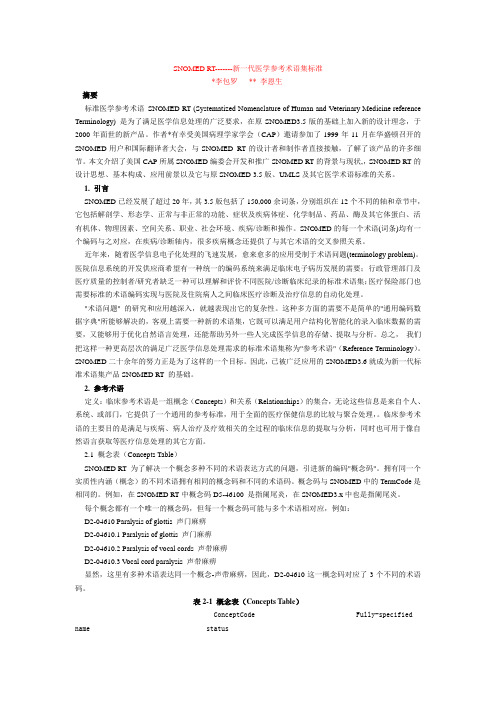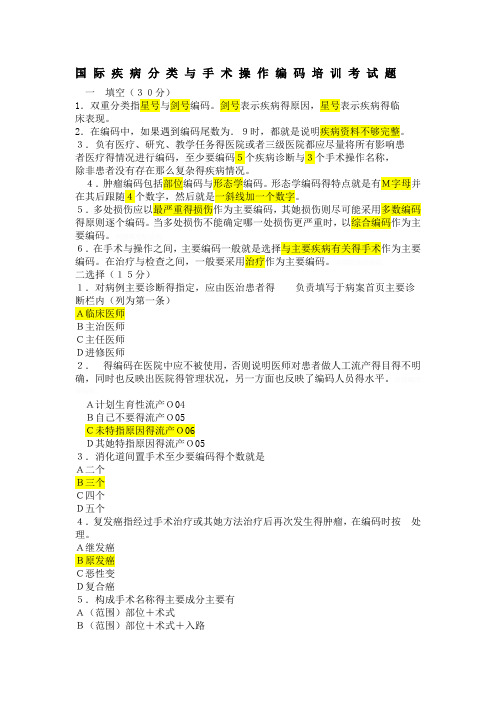The Systematized Nomenclature of Medicine, Clinical Terms (SNOMED CT)
- 格式:pdf
- 大小:94.05 KB
- 文档页数:4

SNOMED RT-------新一代医学参考术语集标准*李包罗** 李恩生摘要标准医学参考术语SNOMED RT (Systematized Nomenclature of Human and Veterinary Medicine reference Terminology) 是为了满足医学信息处理的广泛要求,在原SNOMED3.5版的基础上加入新的设计理念,于2000年面世的新产品。
作者*有幸受美国病理学家学会(CAP)邀请参加了1999年11月在华盛顿召开的SNOMED用户和国际翻译者大会,与SNOMED RT的设计者和制作者直接接触,了解了该产品的许多细节。
本文介绍了美国CAP所属SNOMED编委会开发和推广SNOMED RT的背景与现状,,SNOMED RT的设计思想、基本构成、应用前景以及它与原SNOMED 3.5版、UMLS及其它医学术语标准的关系。
1. 引言SNOMED已经发展了超过20年,其3.5版包括了150,000余词条,分别组织在12个不同的轴和章节中,它包括解剖学、形态学、正常与非正常的功能、症状及疾病体症、化学制品、药品、酶及其它体蛋白、活有机体、物理因素、空间关系、职业、社会环境、疾病/诊断和操作。
SNOMED的每一个术语(词条)均有一个编码与之对应,在疾病/诊断轴内,很多疾病概念还提供了与其它术语的交叉参照关系。
近年来,随着医学信息电子化处理的飞速发展,愈来愈多的应用受制于术语问题(terminology problem)。
医院信息系统的开发供应商希望有一种统一的编码系统来满足临床电子病历发展的需要;行政管理部门及医疗质量的控制者/研究者缺乏一种可以理解和评价不同医院/诊断临床纪录的标准术语集;医疗保险部门也需要标准的术语编码实现与医院及住院病人之间临床医疗诊断及治疗信息的自动化处理。
"术语问题" 的研究和应用越深入,就越表现出它的复杂性。
这种多方面的需要不是简单的"通用编码数据字典"所能够解决的,客观上需要一种新的术语集,它既可以满足用户结构化智能化的录入临床数据的需要,又能够用于优化自然语言处理,还能帮助另外一些人完成医学信息的存储、提取与分析。

国际疾病分类与手术操作编码培训考试题一填空(30分)1.双重分类指星号与剑号编码。
剑号表示疾病得原因,星号表示疾病得临床表现。
2.在编码中,如果遇到编码尾数为.9时,都就是说明疾病资料不够完整。
3.负有医疗、研究、教学任务得医院或者三级医院都应尽量将所有影响患者医疗得情况进行编码,至少要编码5个疾病诊断与3个手术操作名称,除非患者没有存在那么复杂得疾病情况。
4.肿瘤编码包括部位编码与形态学编码。
形态学编码得特点就是有M字母并在其后跟随4个数字,然后就是一斜线加一个数字。
5.多处损伤应以最严重得损伤作为主要编码,其她损伤则尽可能采用多数编码得原则逐个编码。
当多处损伤不能确定哪一处损伤更严重时,以综合编码作为主要编码。
兴纏唢埡标堊巩。
6.在手术与操作之间,主要编码一般就是选择与主要疾病有关得手术作为主要编码。
在治疗与检查之间,一般要采用治疗作为主要编码。
邓鄲错縭級阍載。
二选择(15分)1.对病例主要诊断得指定,应由医治患者得负责填写于病案首页主要诊断栏内(列为第一条)A临床医师B主治医师C主任医师D进修医师2.得编码在医院中应不被使用,否则说明医师对患者做人工流产得目得不明确,同时也反映出医院得管理状况,另一方面也反映了编码人员得水平。
禀潜疇湾諱韫豬。
A计划生育性流产O04B自己不要得流产O05C未特指原因得流产O06D其她特指原因得流产O053.消化道间置手术至少要编码得个数就是A二个B三个C四个D五个4.复发癌指经过手术治疗或其她方法治疗后再次发生得肿瘤,在编码时按处理。
A继发癌B原发癌C恶性变D复合癌5.构成手术名称得主要成分主要有A(范围)部位+术式B(范围)部位+术式+入路4.症状、体征与临床与实验室异常所见,不可归类在她处者(R00~R99)得编码规则。
答:1.当症状、体征与实验室异常所见得病因明确时,此章得编码只作为附加编码。
只有当病因不明确时,此章得编码才能作为主要编码。
类似情况如下:⑴当研究了全部资料后仍找不到能说明诊断得原因时。

国际疾病分类与手术操作编码培训考试题一填空(30分)1.双重分类指星号和剑号编码。
剑号表示疾病的原因,星号表示疾病的临床表现。
2.在编码中,如果遇到编码尾数为.9时,都是说明疾病资料不够完整。
3.负有医疗、研究、教学任务的医院或者三级医院都应尽量将所有影响患者医疗的情况进行编码,至少要编码5个疾病诊断和3个手术操作名称,除非患者没有存在那么复杂的疾病情况。
4.肿瘤编码包括部位编码和形态学编码。
形态学编码的特点是有M字母并在其后跟随4个数字,然后是一斜线加一个数字。
5.多处损伤应以最严重的损伤作为主要编码,其他损伤则尽可能采用多数编码的原则逐个编码。
当多处损伤不能确定哪一处损伤更严重时,以综合编码作为主要编码。
6.在手术与操作之间,主要编码一般是选择与主要疾病有关的手术作为主要编码。
在治疗与检查之间,一般要采用治疗作为主要编码。
二选择(15分)1.对病例主要诊断的指定,应由医治患者的负责填写于病案首页主要诊断栏内(列为第一条)A临床医师B主治医师C主任医师D进修医师2.的编码在医院中应不被使用,否则说明医师对患者做人工流产的目的不明确,同时也反映出医院的管理状况,另一方面也反映了编码人员的水平。
A计划生育性流产O04B自己不要的流产O05C未特指原因的流产O06D其他特指原因的流产O053.消化道间置手术至少要编码的个数是A二个B三个C四个D五个4.复发癌指经过手术治疗或其他方法治疗后再次发生的肿瘤,在编码时按处理。
A继发癌B原发癌C恶性变D复合癌5.构成手术名称的主要成分主要有A(范围)部位+术式B(范围)部位+术式+入路C(范围)部位+术式+入路+麻醉方式D(范围)部位+术式+入路+疾病性质三判断(15分)1.糖尿病的并发症需要指出糖尿病的性质才能准备编码。
√2.在手术与操作之间,主要编码一般是选择与主要疾病相关的手术作为主要编码,在治疗与检查之间,一般要采用操作作为主要编码。
×3.在本次医疗事件中,选择对健康危害最严重、花费医疗精力最多、住院时间最长的诊断作为患者的主要诊断。
![]MTI缩略语大全分解](https://img.taocdn.com/s1/m/cad2142753d380eb6294dd88d0d233d4b14e3fbc.png)
MTI缩略语大全分解MTI是一种短语,代表着匹配文本信息(Matching Text Information)的缩写。
以下是一些与MTI有关的缩略语的分解:MTI•M atching T ext I nformation(匹配文本信息)MTI常被用来描述自然语言文本和医学文本中的概念和实体。
该术语最初出现在计算语言学中,在机器学习和人工智能方面非常有用。
UMLS•U nified M edical L anguage S ystem(统一医学语言系统)UMLS是由美国国家医学图书馆(National Library of Medicine)开发和维护的一套医学词汇集。
它是一种跨医学学科、跨文化语言的用于医学目的的语言系统,用于实现各种医学计算机应用程序的交互操作。
MeSH•M edical S ubject H eadings(医学主题词)MeSH是一种医学主题词,用于分类和组织医学文献和信息。
它是由美国国家医学图书馆维护的一种结构化词汇。
SNOMED•S ystematized NO menclature of MED icine(医学系统化命名法)SNOMED是一种医学术语系统,用于描述临床概念和实体。
它是由国际卫生技术标准化组织(International Health Terminology Standards Development Organisation,IHTSDO)维护的。
NLP•N atural L anguage P rocessing(自然语言处理)NLP是一种计算机科学和人工智能领域的交叉学科,致力于让计算机能够理解、处理、生成和翻译自然语言。
ICD•I nternational C lassification of D iseases(国际疾病分类)ICD是由世界卫生组织(World Health Organization,WHO)维护的一套国际通用的疾病分类系统,用于编码医学诊断、手术过程、疾病和死因。

医学术语国外标准及标准组织国外标准及标准组织ATC ( Anatomical Therapeutic Chemical ) 解剖-治疗-化学代码;是一种药物系统分级分类法。
在19世纪 70年代初,挪威医学供应部扩展了已有的欧洲制药市场研究协会解剖和治疗 3 级分类系统,并增加了 2 个化学级。
后来, ATC 分类获得 WHO 药物应用研究组认可,并由在奥斯陆的 WHO 药物统计方法合作中心 (WHO Collaborating Centre for Drug Statistics Methodology) 负责维护。
ATC 的优点如下:(1)确定了一个药物产品,包括有效物质、用药途径和相关的剂量。
(2)既面向治疗、又面向化学药品,这个特征是其他系统所缺乏的。
(3)其分级结构允许逻辑分组。
( 4)已作为 WHO 药物应用研究的国际标准。
缺点是:没有包含复合产品、皮肤病制剂和局部用的复方制剂。
相关资料: http://www.umanitoba.ca/centres/mchp/concept/dict/drug/Atc-ext.htm CPT ( Current Procedural Terminology, 美国)通用过程术语学;是美国的付帐赔偿编码体系中使用的一套编码系统,基于消费来定义诊断和治疗过程,提供了编码策略。
是医院所使用的临床操作与提供服务的分类编码与术语体系,在美国的付款和应用评估方面广为使用。
每年由美国医学会 (American Medical Association ,AMA) 发布一次。
(在论坛的一些国外 DEMO 上,常可见到 CPT4 ,指的是CPT 的第四版本: Current Procedural Terminology,4th Edition )DICOM 标准( Digital Imaging and Communication in Medicine )--本论坛讨论栏目:医学影像技术、 Pacs 系统、 DICOM3 标准详DRG ( Diagnosis Related Groups ,美国)中文名:诊断相关组;由美国 HCFA ( Health Care Financing Administration )制定,是用于美国医疗保险预付款制度的分类编码标准。

医疗卫生常用术语缩写(1)EHR:Electronic Health Records,居民电子健康档案(2)EMR:Electronic Medical Record,电子病历记录(3)PHR:Personal Health record,个人健康记录(4)CHIS:Community Health Information System,社区卫生服务信息系统(5)CHSS:Community Health Service System 社区卫生服务系统(6)HIS:Hospital Information System,医院信息系统(7)CIS:Clinical Information System,临床信息系统(8)LIS:Laborary Information System,实验室信息系统(9)PACS:Picture Archiving And Communication Systems,医学影像存档与通讯系统(10)RIS:Radioiogy Information System,放射信息管理系统(11)POS:Point of Service,基本业务信息系统(12)GIS:Geographic Information System,地理信息系统(13)HL7:Health Level 7 卫生信息交换第七层协议(14)CDA:Clinical Document Architecture 临床结构化文档(15)XDS/XDS-I:Cross-Enterprise Document Sharing跨机构文共享(16)HIAL:Health Information Access Layer 区域信息交换层(17)RHIN:Regional Health Information Network 区域医疗信息网络(18)DICOM:Digital Imaging and Communication in Medicine 数字化医学影像传输(19)IHE:Integrating the Healthcare Enterprise医疗信息系统集成技术规范(20)ICD/ICD-10:International Classification of Diseases国际疾病分类(21)MPI:Master Patient Index,病人主索引(22)PIX:Patient Identifier Cross-referencing 患者标识交叉索引(23)RIM:Reference Information Model 参考信息模型------------------------------------------------------------------------------- 1) 电子病历:(EMR,Electronic Medical Record)通过计算机保存、管理、传输和重现的数字化的病人的医疗记录,取代手写纸张病历。
医疗信息学中涉及的各种国际标准一览本页介绍在医学信息中广泛应用到的标准,以便论坛的朋友进行检索。
主要介绍医疗应用方面的标准,对于应用于医疗方面的专业技术标准,如:用于通讯的通讯协议标准UDP、TCP/IP 、FTP等等,以及用于存储的JPEG 、TIFF 、PICF 、FAX 、Media等方面的标准,在涉及的时候,会给出相应的简单说明,但并不列出在下表中,因为此类标准并不需要医院的IT人员了解也会广泛应用在各个方面,其医疗方面的应用标准,如果医院的人员和医学信息学的研究人员不了解的话,是无法获得更好的应用和发展的,也无法借鉴其中成功的或者是失败的标准化经验。
本页编排以各标准的首字母顺序为序,在各标准后标有"详"字样的,表示可以点击相关链接有详细的介绍;在本页仅提供相关的网址,或仅有简单介绍的,则表明没有更多的资料,欢迎各位网友提供更多的相关资料。
本页的整理和维护由ironstone负责,有相关问题,请于其联系。
在了解这些标准体系和编码体系之前,应当注意到的是:所有分类编码系统都有缺点,没有一个编码体系能满足所有用户的需求。
因此,在了解了这些标准后,了解这些标准体系的适用范围、使用目的和使用人群是非常重要的。
国外标准及标准组织:ATC(Anatomical Therapeutic Chemical)解剖-治疗-化学代码;是一种药物系统分级分类法。
在19世纪70年代初,挪威医学供应部扩展了已有的欧洲制药市场研究协会解剖和治疗3级分类系统,并增加了2个化学级。
后来,ATC分类获得WHO药物应用研究组认可,并由在奥斯陆的WHO药物统计方法合作中心(WHO Collaborating Centre for Drug Stati stics Methodology)负责维护。
ATC的优点如下:(1)确定了一个药物产品,包括有效物质、用药途径和相关的剂量。
(2)既面向治疗、又面向化学药品,这个特征是其他系统所缺乏的。
93数字化医院系列软件健康体检信息管理系统简介福州玖叁医药软件技术服务有限公司93医院健康体检信息管理系统介绍1.前言:“93医院体检信息管理系统”<93PIS)是面向医院体检中心量身定制的计算机自动化管理系统,该系统本着从医院体检的实际应用出发,结合医院管理信息化<HIS)、医学图像存储与传输系统<PACS)、检验科管理系统<LIS)、临床管理信息化<CIS)的综合应用,利用计算机网络管理的优势,将信息采集点遍布医院活动的每一个角落,形成各诊疗科室信息的互联共享,实现了电子化管理,无纸化工作,网络化服务的目标,是建设现代化医院的必经之路。
由我公司<玖叁医药软件技术服务有限公司)开发的“93医院体检信息管理系统”,依靠计算机网络化信息化管理的优势,以体检人员为中心,以体检流程主线,全过程自动化采集信息,各系统之间采用标准接口,生成完成医疗体检信息电子化档案;再根据模板、套餐、体检项目解释意义库,疾病解释诊断治疗知识库,国际标准医学术语库、专家建议库,专家生活保健指导库等丰富的专家知识数据库,能方便快捷生成体检报告;完整的原始信息和科学合理的体检报告建议等,可进行各类综合统计与分析,如量化分析,疾病谱分析等,通过分析过程,为体检单位提供符合客观实际的职工健康情况分析报告,为体检单位提供准确的决策信息;本系功能强大,但使用严格的管理权限,各登陆用户只能根据授权进行操作;后台采用大型数据库ORACLE数据库并能与Internet连接,体检单位可通过网络进行体检预约、查询等操作。
更有健康档案管理、客户关怀管理、触摸屏导医管理、内部物资进出存管理、网站管理,再加上短信平台、E_mail平台,电话传真平台等多种与客户联系通道,使系统更具有效率和生命力,也为医院拓展业务提供广阔的技术应用平台。
2.问题分析:在物质生活越来越丰富的现代社会,健康备受关注。
企业招工、学生入学、特定职位的定期体检、各种职业病的防范、甚至个人随着人民生活水平不断提高,人们对于健康认识不断加强,从原来单纯地到医院看病就医转变到预防为主的一种新型生活模式。
国际疾病分类与手术操作编码培训考试题一填空(30分)1.双重分类指星号和剑号编码。
剑号表示疾病的原因,星号表示疾病的临床表现.2.在编码中,如果遇到编码尾数为.9时,都是说明疾病资料不够完整。
3.负有医疗、研究、教学任务的医院或者三级医院都应尽量将所有影响患者医疗的情况进行编码,至少要编码5个疾病诊断和3个手术操作名称,除非患者没有存在那么复杂的疾病情况。
4.肿瘤编码包括部位编码和形态学编码.形态学编码的特点是有M字母并在其后跟随4个数字,然后是一斜线加一个数字.5.多处损伤应以最严重的损伤作为主要编码,其他损伤则尽可能采用多数编码的原则逐个编码。
当多处损伤不能确定哪一处损伤更严重时,以综合编码作为主要编码。
6.在手术与操作之间,主要编码一般是选择与主要疾病有关的手术作为主要编码.在治疗与检查之间,一般要采用治疗作为主要编码.二选择(15分)1.对病例主要诊断的指定,应由医治患者的负责填写于病案首页主要诊断栏内(列为第一条)A临床医师B主治医师C主任医师D进修医师2.的编码在医院中应不被使用,否则说明医师对患者做人工流产的目的不明确,同时也反映出医院的管理状况,另一方面也反映了编码人员的水平.A计划生育性流产O04B自己不要的流产O05C未特指原因的流产O06D其他特指原因的流产O053.消化道间置手术至少要编码的个数是A二个B三个C四个D五个4.复发癌指经过手术治疗或其他方法治疗后再次发生的肿瘤,在编码时按处理。
A继发癌B原发癌C恶性变D复合癌或放疗的情况为主要编码。
化疗或放疗的患者在治疗期间死亡,选择肿瘤的编码为主要编码.4.症状、体征和临床与实验室异常所见,不可归类在他处者(R00~R99)的编码规则.答:1.当症状、体征和实验室异常所见的病因明确时,此章的编码只作为附加编码。
只有当病因不明确时,此章的编码才能作为主要编码.类似情况如下: ⑴当研究了全部资料后仍找不到能说明诊断的原因时。
⑵由于起初的症状和体征很短暂而不能确定病因时. ⑶诊断作出之前患者已转院、出院或死亡时。
snomedct标准Snomedct标准。
Snomedct(Systematized Nomenclature of Medicine Clinical Terms)是一种全球范围内用于医学临床术语的标准化编码系统,它的主要作用是用于医学信息交流和医学知识管理。
Snomedct标准的制定旨在提高医学信息的准确性、一致性和可比性,从而促进医学信息的共享和利用,为医疗卫生事业的发展提供有力支持。
Snomedct标准的特点之一是其广泛的覆盖范围,可以涵盖从疾病、症状到治疗方法、药品等各个方面的临床术语。
这使得Snomedct标准成为了医学信息管理和医学知识表达的重要工具。
同时,Snomedct标准还具有多语言支持的特点,可以满足不同国家和地区的医学信息交流和管理需求。
在实际应用中,Snomedct标准可以用于构建医学信息系统、临床决策支持系统、医学知识图谱等医学信息化应用。
它可以帮助医护人员更准确地记录和表达临床信息,提高医疗信息的质量和可比性。
同时,Snomedct标准还可以为医学研究和临床实践提供丰富的数据支持,促进医学知识的积累和创新。
除此之外,Snomedct标准还可以用于医学教育和培训。
通过将Snomedct标准纳入医学教育体系,可以帮助医学生更好地理解和运用临床术语,提高其临床实践能力和医学信息管理能力。
总的来说,Snomedct标准在医学信息化、医学知识管理、医学教育和医学研究等方面发挥着重要作用。
它的应用可以提高医学信息的质量和可比性,促进医学知识的共享和创新,推动医疗卫生事业的发展。
在未来,随着医学信息化和医学知识管理的不断发展,Snomedct标准的作用将会越来越重要。
我们有理由相信,Snomedct标准将会成为医学信息化领域的重要标准,为医疗卫生事业的发展做出更大的贡献。
An examination of OWL and the requirements of a large health care terminologyKent SpackmanDepartment of Medical Informatics and Clinical EpidemiologyOregon Health&Science University,Portland,Oregon,USAspackman@Abstract.This paper presents a brief initial look at some of the possiblebenefits and barriers to using OWL as the language for the development,dissemination and implementation of terminological knowledge in the do-main of health and health care.In particular,this assessment is madefrom the perspective of the author’s role in the development of the Sys-tematized Nomenclature of Medicine(SNOMED).To date,SNOMEDhas developed and adopted its own special-purpose syntax and formatsfor terminology development,exchange and distribution.Its represen-tation language has limited expressivity yet is not expressible by anydialect of OWL1.0.With the evolution to OWL1.1,the barriers tousing OWL for knowledge representation have been resolved.However,partly because of SNOMED’s very large size,there remain barriers toadoption of OWL XML/RDF for SNOMED development,distributionor exchange purposes.1IntroductionThe Systematized Nomenclature of Medicine,Clinical Terms(SNOMED CT) [1]is a work of clinical terminology with broad coverage of the domain of health care,and it has been selected as a national standard for use in elec-tronic health applications in many countries,including the U.S.,U.K.,Canada, Australia,Denmark,and others.SNOMED was originally published in1976, while SNOMED CT became available in2002as a major expansion resulting from the merger of SNOMED RT with the U.K.’s Clinical Terms version3.A major distinguishing feature differentiating it from prior editions is the use of description logic(DL)to define and organize codes and terms[2].Another major distinguishing feature of SNOMED is its size and complexity. With over350,000concept codes,each representing a different class,it is an order of magnitude larger than the next largest DL-based ontology of which we are aware.The size of the OWL XML/RDF form of SNOMED is approximately248 MB,and this is just the DL representation without all the synonyms,mappings, subsets,and other special-purpose components of the terminology.2Knowledge RepresentationAs noted by Patel-Schneider[3],the design of OWL has been driven by three main streams of influence:the Semantic Web,description logics,and frame sys-tems.To some degree these three streams canflow together,but in a more important sense they produce conflicting design criteria.From the healthcare terminology perspective,the most useful stream of in-fluences on OWL was the description logic stream.Long prior to the conception of the Semantic Web and the promulgation of related standards,the SNOMED effort had adopted description logic as the representation language for its formal definitions.SNOMED CT was developed with a description logic which includes con-junction( ),existential role restrictions(∃R.C),role hierarchy axioms(r s), and class definitions of the form A C with A a class name and C an arbitrary class description.In addition,it makes use of what have been termed“right iden-tities”,a restricted form of property chain inclusion axioms of the form r◦s r, where the circle denotes role composition.This relatively limited set of language constructs is nevertheless sufficient to represent a very wide range of meanings.Another important property of this limited language,which can be called ELH with right identities,is that its computational complexity remains poly-nomial[4],and there exist classifiers that can handle the task of classifying the entire terminology[5].Without a solid DL foundation,the Semantic Web would have remained largely irrelevant to health care terminology standardization.Even so,the ini-tial version of OWL was developed without taking adequate account of features of DL that had already been used in both the GALEN[6]and SNOMED[7] efforts.The development of OWL1.1eliminated one of the most significant bar-riers to use of OWL for SNOMED,since it permits the identification of tractable sublanguages capable of handling the size and complexity of SNOMED[8].Al-though adding property chain inclusion axioms was reportedly the most difficult step in developing OWL1.1[9],this was essential.Without it,adoption of OWL by the SNOMED community would have required awkward workarounds with their attendant complications and complexities–effectively killing movement in that direction.With it,we have a clear path to using OWL1.1for further development and integration with other biomedical ontologies.3Development and ExchangeBeginning in1995-96,SNOMED’s developers adopted a distributed co-operative model for modeling the DL definitions of its meanings[10].This development model was driven by several factors,including the geographical distribution of health care professionals available to work on curation of the terminology,as well as a recognition of the value of distributed development.In order to successfully handle asynchronous modeling by geographically dis-persed editors,software was developed that permitted each editor to submit “change sets”which could be imported into a central configuration management environment and analyzed for conflicts.The format of these change sets has evolved over time,and SNOMED has recently defined an published an open source specification for an XML interchange format[11].As mentioned above,scale is a major issue for SNOMED.This comes into play when considering the most common tools available for editing and develop-ment of OWL-based work.All open source editing tools that I have tested run into memory problems when dealing with a terminology as large as SNOMED. While some of these barriers will be(or perhaps by the time of this conference have been)removed as a result of special programming effort,it is probable that only a few open source editing tools will receive this level of refinement and enhancement.It is unclear whether most ontologies and terminologies for the semantic web are small-scale because that is the right size,or merely because the tools and resources to build truly useful large terminologies are not available. In health care,at least,it is clear that we need a very large and well-integrated terminology,such as SNOMED.To the extent that OWL assumes that Semantic Web resources will be devel-oped independently and that publication is effectively a static expression of these resources on the Web,then there is no need for standards that permit broad and distributed development,critique,curation,correction,enhancement,or modi-fication.On the other hand,our experience with SNOMED suggests strongly that distributed development is crucial,and therefore it would be important to consider support of this need by OWL standards.Also based on our experience, support for change sets,at least,would not seem to be a very difficult thing to add to the standard.SNOMED’s change set documents are available under the Apache2.0license and could be used as a starting point if desired.4DistributionIn order to be useful,SNOMED has to be integrated into application programs that are in use in the health care environment.Of course,virtually none of the commercial applications in wide use in health care today are built to take account of the Semantic Web.As a result,each vendor or software supplier or health care institution has a slightly different need for terminology standards,and incorpo-rates those standards into their application software in different ways.There is an existing distribution format for SNOMED,based on a set offiles of UTF-8characters suitable for loading into database tables.In order to pro-vide application developers with a stable specification,this distribution format was submitted for American National Standards Institute(ANSI)standardiza-tion[12].This structure has served its purpose for several years.However,as the knowledge representation evolves and there is a need for more expressiveness,the current format has become limiting.As a result,a special-purpose XML format has been developed and published for comment[13].Once again,it would seem that it would be worthwhile to examine the representation capabilities of OWL 1.1as a means for representing at least the DL-based components of SNOMED. Other components,such as change tracking,mapping,subsetting,and so forth may not be as readily represented in OWL.However,these issues facing termi-nologies in health care are probably not unique to this one domain,and it would be worth examining the extent to which an enhanced OWL standard mightcontribute to improved use of terminologies across several industries,thereby increasing the chances of the Semantic Web vision being realized.5ConclusionWe have discussed several issues that have arisen in the process of examining the utility of OWL and its associated products for the purposes of supporting ongoing efforts to formalize representation of terminology for health and health care.The move to OWL1.1is seen as a very positive move from a knowledge representation standpoint.Support for large scale and distributed development of ontologies is seen as a need that is as yet unmet.References1.Snomed Clinical Terms.Northfield,IL:College of American Pathologists,2007.2. F.Baader,D.Calvanese,D.L.McGuinness,D.Nardi,and P.F.Patel-Schneider,editors.The Description Logic Handbook.Theory,Implementation,and Applica-tions.Cambridge,U.K.:Cambridge University Press,2003.3.P.F.Patel-Schneider.What is OWL(and why should I care)?Ninth Interna-tional Conference on the Principles of Knowledge Representation and Reasoning.Whistler,Canada,June2004.4. F.Baader,S.Brandt,and C.Lutz.Pushing the EL envelope.In Proc.of theNineteenth Int.Joint Conf.on Artificial Intelligence(IJCAI-05),Edinburgh,UK, 2005.Morgan-Kaufmann Publishers.5. F.Baader,C.Lutz,and B.Suntisrivaraporn.CEL—a polynomial-time reasoner forlife science ontologies.In U.Furbach and N.Shankar,editors,Proc.of the3rd Int.Joint Conf.on Automated Reasoning(IJCAR’06),volume4130of Lecture Notes in Artificial Intelligence,pages287–291.Springer-Verlag,2006.6. A.L.Rector,S.K.Bechhofer, C. A.Goble,I.Horrocks,W. A.Nolan andW.D.Solomon.The GRAIL Concept Modelling Language for Medical Termi-nology,Artificial Intelligence in Medicine,9:139-171,1997.7.K.A.Spackman.Managing clinical terminology hierarchies using algorithmic cal-culation of subsumption:Experience with SNOMED-RT.2000.OHSU Technical Report.8. B.C.Grau,I.Horrocks,B.Parsia,P.Patel-Schneider and U.Sattler.Next Stepsfor OWL.Proceedings of the Second OWL Experiences and Directions Workshop (OWLED)2006.9.M.Horridge,D.Tsarkov,and T.Redmond.Supporting early adoption of OWL1.1with Protege-OWL and FaCT++.Proceedings of the Second OWL Experiences and Directions Workshop(OWLED)2006.10.K.E.Campbell,S.P.Cohn,et.al.Galapagos:Computer-based support for evolu-tion of a convergent medical terminology.Proc AMIA Annu Fall Symp1996,pp.269-273.11.SNOMED Interchange Format Specification.College of American Pathologists,2006./snomedct/interchange format.html.12.Healthcare Terminology Structure:ANSI Standard.College of American Patholo-gists,2003.13.SNOMED XML Schema Specification.College of American Pathologists,2006./snomedct/xml schema.html.。